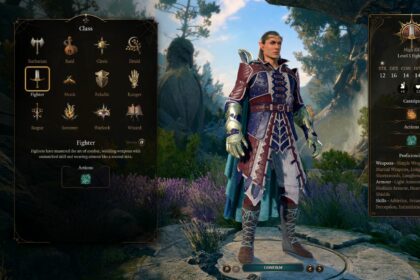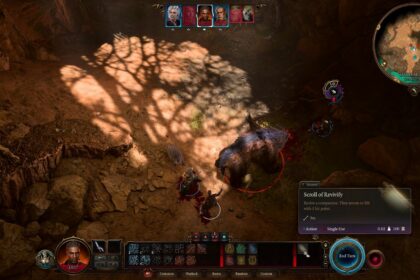Rogues in Baldur’s Gate 3 are the epitome of stealth, skill, and uncanny reflexes.
With their primary ability in Dexterity, proficiency in light armor, and a wide range of weapon choices, they excel at taking out unaware or distracted targets with Sneak Attacks.
Whether you prefer lurking in the shadows, striking from afar, or outsmarting your foes, your Rogue character can shine in any adventure.
Our Baldur’s Gate 3 Rogue Class guide has everything you need to optimize your rogue character and have fun from the shadows.

Rogue Class Features
Hit Points:
- Hit Points at 1st level: 8 + Constitution Modifier
- Hit Points at Higher Levels: 5 + Constitution Modifier
Proficiencies:
- Armor: Light Armor
- Weapons: Simple Weapons, Hand Crossbows, Longswords, Rapiers, Shortswords
- Saving Throws: Dexterity, Intelligence
- Skills: Choose 4 skills from – Acrobatics, Athletics, Deception, Insight, Intimidation, Investigation, Perception, Performance, Persuasion, Sleight of Hand, Stealth
Equipment:
- Leather Armour, Leather Boots
- Shortsword
- Thieves’ Tools, Grease Bottle x2, Health Potion x2, Scroll of Revivify
Unique Class Feature:
- Sneak Attack

Rogue Class Progression
| Level | Features |
|---|---|
| 1 | Choose Expertise in 2 Skills (Class Feature) and Sneak Attack Damage: 1d6 |
| 2 | Cunning Action: Hide (Bonus Action), Dash (Bonus Action), and Disengage (Bonus Action) |
| 3 | Pick a Rogue Subclass (Thief, Arcane Trickster, or Assassin) and Sneak Attack Damage: 2d6 |
| 4 | Feat: Choose one from the Feats list |
| 5 | Uncanny Dodge (Class Feature) and Sneak Attack Damage: 3d6 |
| 6 | Choose Expertise in 2 Skills (Class Feature) |
| 7 | Evasion (Class Feature) and Sneak Attack Damage: 4d6 |
| 8 | Feat: Choose one from the Feats list |
| 9 | Subclass Feature and Sneak Attack Damage: 5d6 |
| 10 | Feat: Choose one from the Feats list |
| 11 | Reliable Talent (Class Feature) and Sneak Attack 6d6 (Action) |
| 12 | Feat: Choose one from the Feats list |
Sneak Attack (Melee)
Sneak Attack is the Rogue’s signature move in Dungeons & Dragons and it has been there for a long, long time.
Originally, rogues would receive a significant damage boost when striking their enemies from behind.
In Baldur’s Gate 3, Rogues unleash additional damage upon a target you have an Advantage against.
This ability also activates when you have an ally within 1.5 meters of the target, and you are not suffering from Disadvantage.
Sneak Attack (Ranged)
Deal bonus damage to a target you have an Advantage against. This ability is also accessible when you have an ally within 1.5 meters of the target, and you are not under Disadvantage.
Ranged and Melee sneak attack are really the same thing, although the game seems to differentiate them for some reason.
In both cases, you need either advantage against the target or an ally next to it. You must use a ranged weapon.
Expertise
Your Proficiency Bonus is doubled for any ability check involving either of your chosen Proficiencies.
Cunning Action: Hide
Conceal yourself from enemies by succeeding in Stealth checks. Stay within the shadows to avoid enemy detection. Bear in mind that attacking or casting spells will reveal your location.
Cunning Action: Dash
With a bonus action, you can increase your movement speed twofold for the current turn, allowing you to cover more ground.
Cunning Action: Disengage
Disengage is an action that allows you to move without provoking Opportunity Attacks. Rogues can use a bonus action to activate Disengage.
Secure a safe retreat; moving will not provoke Opportunity Attacks during this turn.
Uncanny Dodge
Uncanny Dodge allows you to reduce incoming attack damage by half as a reaction
When an attack lands while Uncanny Dodge is active, you only suffer half the typical damage. This only words once per round.
Uncanny Dodge is a toggleable passive that activates upon the first attack that strikes you.
Evasion
Your agility enables you to dodge certain spells effectively.
When facing a spell or effect that would deal half damage upon a successful Dexterity Saving Throw, you suffer no damage on success and only half damage on failure.
Reliable Talent
When you perform an Ability Check involving a Skill you are Proficient in, the lowest result you can roll on the die is 10.
Master Your Sneak Attack
Sneak Attack can be optimized for maximum impact when you configure it to trigger automatically, making it a lot more natural and opening the possibilities for a number of combos.
Once that is done, you will be able to combine sneak attack with Weapon Actions and special attacks, allowing you to burst down an enemy surprisingly fast.
Make sure to check your Reactions tab to set up an Automatic Sneak attack trigger.
Gaining Advantage for Sneak Attack
Executing a successful Sneak Attack hinges on securing Advantage in battle. Here are some strategies to help you gain this advantage:
- Stealth and Invisibility: One of the most effective approaches is to strike your target while hidden or invisible, catching them off guard.
- Prone or Sleeping Targets: Seize the opportunity presented by prone or sleeping foes. These conditions create a vulnerability that allows you to strike with precision, particularly against creatures within a 3-meter radius.
- Exploiting Enemy Weakness: Capitalize on your target’s vulnerability when they suffer from conditions like blindness, entanglement, or paralysis (e.g., the “Blinded,” “Entangled,” or “Hold Person” spell). These debilitations make them easy prey for your Sneak Attack.
Weapon Considerations for Rogues

For Rogue class characters, choosing the right weapon for your main hand when using Sneak Attack can be a critical decision.
You need finesse weapons, and this alone can feel detrimental, but the right magic dagger can do wonders to your damage output.
If you can, make sure to get the weapon called “Bloodthirst” since reduces critical hit requirements and makes enemies vulnerable to piercing damage.
This allows you to deal double damage when using a piercing weapon, like a dagger or a rapier, effectively doubling your damage.
Since your sneak attack damage is also doubled, your burst potential becomes obscenely powerful.
Rogue Subclasses
At Level 3, rogues choose their subclass, altering their playstyle and abilities to excel in various aspects of stealth, cunning, and combat.
In Baldur’s Gate 3, the Rogue class provides players with three intriguing subclasses to choose from: Thief, Arcane Trickster, and Assassin.
Each of these subclasses offers distinct abilities and playstyle options, allowing players to customize their Rogue characters for diverse in-game experiences.
Rogues may not match the raw power of fighters or the magical prowess of wizards, but their finesse, precision, and versatility in both combat and skullduggery make them indispensable members of any adventuring party.
- Thief: Embodies the classic nimble and agile rogue archetype, excelling in mobility and versatility.
- Arcane Trickster: Blends rogue skills with arcane magic, allowing for spellcasting and sneak attacks with spells.
- Assassin: Focuses on delivering lethal burst damage to unsuspecting enemies with a knack for ambushes and stealth.
Thief Subclass

Thiefs are sneakier than most rogues.
They can perform extra attacks with an extra bonus action, are hard to catch, and can be always a step ahead provoking the enemy and breaking their defense lines.
| Level | Features |
|---|---|
| 3 | Fast Hands, Second-Story Work |
| 9 | Supreme Sneak |
Thief Features and Tips
Thieves might seem underwhelming at first, but don’t be fooled.
These rogues have impressive features that, although hard to use well at first, can prove to be quite powerful.
One extra bonus action, for instance, might not seem like much, but it is one of the best features in the game.
- Fast Hands (Level 3): This ability grants you an additional bonus action, allowing you to make an extra off-hand attack or perform any other bonus action. In Baldur’s Gate 3, Fast Hands offers incredible versatility, making it one of the most potent abilities in the game.
- Second-Story Work (Level 3): With Second-Story Work, you’ll take half damage from falling, enhancing your survivability, especially when navigating heights and falls.
- Supreme Sneak (Level 9): Acquired at level 9, Supreme Sneak is an action that lets you turn completely invisible. This invisibility is a valuable tool for repositioning, escaping, or launching surprise attacks. Keep in mind that attacking while invisible will break the invisibility.
Thief Multiclass Builds
Among the specific benefits of multiclassing, you’ll find enhanced combat versatility, the art of stealthy spellcasting, and improved survivability.
Thief Rogue (9) / Monk (3):
- Build Description: This fusion of Thief Rogue and Shadow Monk brings together the sneakiness of a Rogue with the agility and mobility of a Monk. Shadow Monks can cast Darkness, allowing you to teleport between shadows for stealthy maneuvers. Stunning Strike and Evasion amplify your combat survival and control capabilities.
- Mechanical Benefits:
- Shadow Step and Silence from Shadow Monk bolster your stealth capabilities.
- Stunning Strike disrupts enemy actions, providing crowd control.
- Utilize Thief Rogue’s Fast Hands for item interactions and Cunning Action for increased mobility.
Thief Rogue (9) / Warlock (3):
- Build Description: This multiclass build enriches your magical repertoire and utility. With Pact of the Chain, you gain an improved familiar, ideal for scouting and exploration. Eldritch Blast ensures reliable ranged damage, ensuring you remain a formidable force even when stealth isn’t an option. The synergy lies in enhancing your versatility and adding a layer of eldritch power to your Rogue abilities.
- Mechanical Benefits:
- Combine Thief Rogue’s expertise in skills like Stealth with Warlock spells like Invisibility and Mage Armor for enhanced stealth and protection.
- Eldritch Invocations grant you unique abilities and enhancements.
Thief Rogue (9) / Wizard (3):
- Build Description: This multiclass build harmonizes the cunning Rogue with the spellcasting prowess of a Wizard. Opt for the School of Illusion to blend seamlessly with your sneaky playstyle. Spells like Invisibility and Silent Image enhance your stealth, while Wizard spells diversify your capabilities for both offense and defense. The synergy lies in making you a versatile spellcaster and a skilled rogue. It’s kinda like being a rogue that is both a Thief and an Arcane Trickster.
- Mechanical Benefits:
- Prioritize Thief Rogue’s expertise and mobility to navigate tricky situations.
- Fast Hands for item interactions and Supreme Sneak for invisibility.
- Wizard spells expand your spellcasting options, both offensively and defensively.
Thief Rogue (9) / Trickery Cleric (3):
- Build Description: This multiclass build unites divine magic and deception, offering a potent blend of Trickery Cleric and Thief Rogue abilities. Trickery Clerics bring spells like Pass without Trace and Mirror Image, synergizing beautifully with your rogueish talents. Channel Divinity: Invoke Duplicity creates distractions and adds another layer of deception. The synergy lies in enhancing your versatility and bringing divine trickery to your rogue toolkit.
- Mechanical Benefits:
- Focus on Thief Rogue skills and abilities, including Fast Hands for item interactions.
- Trickery Cleric spells reinforce your stealth and deception capabilities.
- Channel Divinity option aids in creating confusion among your enemies.
Arcane Trickster Subclass

The Arcane Trickster is the Rogue’s version of the Eldritch Knight.
You are a rogue, but you have access to some spells instead of gaining more rogue-like skills like the Assassin or the Thief do.
Arcane Trickster Features Progression
Arcane Tricksters blend Rogue skills with arcane magic, providing a unique playstyle.
| Level | Features |
|---|---|
| 3 | Arcane Trickster Spellcasting, Mage Hand Legerdemain |
| 7 | Arcane Trickster Spellcasting |
| 9 | Magical Ambush |
| 10 | Choose 1 additional Arcane Trickster Cantrip |
Arcane Trickster Features and Tips
Here’s how to optimize your Arcane Trickster:
- Spellcasting: Arcane Tricksters can apply Sneak Attack damage to (Ranged) Spell Attacks that require Attack Rolls, such as Fire Bolt or Eldritch Blast.
- You can cast cantrips and level 1 spells when you get this feature.
- You can cast level 2 spells at level 7.
- Start with Mage Hand and two other Cantrips at level 3 (additional cantrips at level 10).
- Spell Save DC: 8 + your Proficiency bonus + your Intelligence modifier.
- Spell Attack Modifier: your Proficiency bonus + your Intelligence modifier.
- Magical Ambush (Level 9): While hidden, your targets have Disadvantage on Saving Throws against your Spells. This ability enhances your spellcasting effectiveness when attacking from a concealed position.
- Warped Headband of Intellect: Consider equipping this item, which sets Intelligence to 17 and allows you to allocate points elsewhere for improved overall character efficiency.
Arcane Trickster Multiclass Builds
Arcane Tricksters, while versatile, might seek to augment their abilities further. Multiclassing offers a path to unlock new potential, forging unique combinations.
1. Arcane Trickster Rogue (9) / School of Enchantment Wizard (3):
- Build Description: Focused on enchantment magic and rogue abilities, this build is designed for level 12 gameplay. It allows you to control and manipulate enemies with enchantment spells, making them vulnerable to your Sneak Attacks. Spells like Hold Person and Charm Person can be potent tools in your arsenal, making you an adept crowd-controller.
- Mechanical Benefits:
- Enchantment spells with improved saving throw effects.
- Rogue’s Sneak Attack pairs well with spells like Hold Person.
- Versatile in both combat and social encounters.
2. Arcane Trickster Rogue (9) / Trickery Domain Cleric (3):
- Build Description: Tailored for level 12 adventures, this build combines rogue’s stealth and trickery with divine deception. You gain access to illusion spells, improved stealth, and debuff spells like Dominate Person and Polymorph. Invoke Duplicity and Mage Hand Legerdemain offer creative opportunities for misdirection and stealthy tactics.
- Mechanical Benefits:
- Improved stealth and deception abilities.
- Access to illusion and debuff spells.
- Unique synergy between Invoke Duplicity and Mage Hand Legerdemain.
3. Arcane Trickster Rogue (8) / Warlock (4):
- Build Description: This multiclass build is designed for level 12 gameplay, blending rogue’s finesse with eldritch power. By choosing the right invocations and patron, you can enhance your rogue abilities. Eldritch Blast provides ranged damage when Sneak Attack isn’t an option. This build allows you to focus on Charisma as your primary spellcasting stat, leaving Intelligence for rogue skills.
- Mechanical Benefits:
- Eldritch Blast for ranged damage.
- Access to eldritch invocations for various benefits.
- Charisma-based spellcasting for simplicity.
4. Arcane Trickster Rogue (8) / Champion Fighter (4):
- Build Description: Focusing on critical strikes, this build remains effective up to level 12. It combines Rogue’s core abilities with Champion Fighter features. Action Surge and the Help action from your familiar allow you to make multiple Sneak Attacks in a single round. Whether using Booming Blade or other melee attacks, this build maximizes damage potential.
- Mechanical Benefits:
- Critical hit on 19s with Champion Fighter features.
- Familiar provides the Help action for advantage.
- Action Surge for extra attacks in a turn.
5. Arcane Trickster Rogue (8) / Battle Master Fighter (4):
- Build Description: Designed for tactical combat, this multiclass build retains Rogue’s stealth and skill proficiency while enhancing combat versatility with Battle Master maneuvers. Abilities like Riposte and Action Surge enable additional Sneak Attacks during your enemies’ turns. With a familiar providing advantage, you can effectively capitalize on your combat skills.
- Mechanical Benefits:
- Battle Master maneuvers add tactical options.
- Riposte allows for reaction attacks with Sneak Attack.
- Familiar provides advantage for consistent Sneak Attacks.
Assassin Subclass

The Assassin is the Rogue subclass tailored for dealing substantial burst damage to foes, particularly effective against unprepared enemies or creatures that haven’t taken a turn.
| Level | Features |
|---|---|
| 3 | Assassinate: Initiative, Assassinate: Ambush, Assassin’s Alacrity |
| 9 | Infiltration Expertise |
Assassin Features and Tips
Here’s how to maximize your Assassin character’s potential:
- Assassinate: Initiative (Level 3): This feature grants Advantage on Attack Rolls against creatures that haven’t taken a turn yet. It reflects the Assassin’s deadliness against unprepared foes, setting the stage for devastating opening strikes in combat.
- Assassinate: Ambush (Level 3): Any successful Attack Roll against a Surprised creature is treated as a Critical Hit. This ability emphasizes the Assassin’s ability to deliver lethal blows to unsuspecting enemies, especially during surprise rounds or ambushes.
- Assassin’s Alacrity (Level 3): This feature ensures that your character immediately restores Actions and bonus actions at the start of combat, ensuring Assassins are always ready for action.
- Infiltration Expertise (Level 9): This action allows you to adopt a new identity, changing your appearance. Use it for concealing your true appearance or assuming disguises in various situations, particularly in exploration and combat.
Assassin Rogue Multiclass Builds
Here are some intriguing multiclass builds for the cunning Rogue Assassin.
The Ninja
Assassin Rogue (7) / Shadow Monk (5):
- Build Description: This particular build is great for mobility and precise strikes. Combining the Rogue’s assassin skills with the Monk’s agility, this build is designed for level 12 gameplay in Baldur’s Gate 3.
- Mechanical Benefits:
- Combine Rogue’s Sneak Attack and Monk’s Martial Arts for precise strikes.
- Gain Monk features like Shadow Step for teleportation and Stunning Strike for crowd control.
- Enhance stealth and infiltration capabilities for strategic assassinations.
- One Extra Attack after reaching level 5 as a Monk.
Arcane Infiltrator
Assassin Rogue (8) / Wizard (4):
- Build Description: This combination turns you into an Arcane Infiltrator who fuses arcane magic with stealthy assassination techniques. It also functions somewhat like having traits of both an Assassin Rogue and an Arcane Trickster, thanks to the addition of Wizard spells.
- Mechanical Benefits:
- Augment your assassin’s toolkit with spells like Invisibility, Mage Armor, and Shield.
- Utilize Rogue’s Evasion and Uncanny Dodge alongside Wizard’s versatility.
- Improve survivability and utility in both combat and exploration.
Merciless Duelist
Assassin Rogue (7) / Battle Master Fighter (5):
- Build Description: This is a powerful and cruel build that I like to call, The Merciless Duelist. It excels in one-on-one combat and tactical maneuvering. This build, optimized for level 12, combines the Assassin’s lethality with Fighter’s combat expertise.
- Mechanical Benefits:
- Exploit Rogue’s Assassinate feature for critical hits against surprised foes.
- Utilize Fighter’s Action Surge for additional attacks and precision strikes.
- Master Battle Master maneuvers for battlefield control, versatility, and combat advantage, allowing efficient use of Sneak Attack damage.
- One Extra Attack after reaching level 5 as a Fighter.
The Venomous Saboteur
Assassin Rogue (8) / Trickery Domain Cleric (4):
- Build Description: This one I like to call “The Venomous Saboteur” due to how it blends divine trickery with deadly strikes. The concept is not that different from taking Wizard levels, but you learn a different kind of magic instead.
- Mechanical Benefits:
- Inflict poison damage with the Trickery Domain’s Divine Strike.
- Enhance stealth and deception using Rogue abilities and Cleric spells like Mirror Image.
- Utilize Channel Divinity: Invoke Duplicity to create cunning distractions in combat, adding versatility to your tactics.
How to Make the Most Out of a Rogue

Rogues are versatile and cunning adventurers in the world of Dungeons and Dragons, capable of feats that range from picking locks to landing deadly sneak attacks.
With these tips and tricks, you’ll be well-equipped to navigate the challenges of Baldur’s Gate 3 as a cunning and resourceful Rogue.
Exploit Evasion and Uncanny Dodge
Rogues gain Evasion, allowing them to take half damage from area-effect spells on successful Dexterity saving throws.
Uncanny Dodge lets you halve incoming attack damage as a reaction. Highlight the importance of these abilities for survivability.
Lockpicking and Trap Disarming
Offer practical advice on using Thieves’ Tools and your character’s skills to handle locks and traps effectively. Explain that proficiency in these tools is vital for a Rogue.
Resource Management
Discuss the importance of managing resources like Sneak Attack and spell slots efficiently, especially in longer adventures.
Offer tips on when to use these abilities strategically.
Choose Your Race Wisely

Opt for a Race and Subrace that enhance your Rogue abilities. Consider Wood Elf or Wood Half-Elf for extra combat mobility or Deep Gnomes for an Advantage on Stealth Checks.
Pick Your Subclass with Purpose
Carefully select a Rogue Subclass that suits your playstyle, whether it’s Thief, Assassin, or Arcane Trickster.
Build your character accordingly to maximize your Subclass advantages.
Master Dual Wielding
When assigning Feats, consider Dual Wield Proficiency. It grants an extra bonus action, especially valuable for dual-wielding Rogues, allowing for tactical advantages.
Embrace Ranged Combat
Don’t limit your Rogue to daggers. Equip a bow to engage in ranged combat and deal damage from a distance.
Use Stealth Attacks with ranged weapons for added versatility.
Also, remember that magic daggers return to your hand after thrown, so do it instead of risking taking damage if you can use your sneak attack at a distance.
Exploit Stealth Attacks
Stealth is your strength. Use Stealth Attacks when invisible for substantial damage while staying hidden. Feats providing extra actions can facilitate smoother Stealth entry.
Utilize Invisibility Spells
Prioritize acquiring invisibility spells and items granting invisibility skills. Stealth is crucial, and these spells improve your ability to remain concealed based on your level, Subclass, and Race.
Configure Reactions Thoughtfully
Pay attention to party members’ Reaction settings. Reactions allow for specific actions during battle, like sneak attacks.
Adjust their behavior if needed to align with your strategy without disrupting combat flow.
Equip Thieves’ Tools and Trap Gear
Always carry Thieves’ Tools and Trap Disarming equipment. These items enable lockpicking and trap disarming, essential skills for a Rogue.
Having these tools ensures multiple attempts without needing Inspiration.
Consider Feats

Discuss specific Feats that can enhance a Rogue’s capabilities, such as Alert for improved initiative or Sharpshooter for ranged attacks. Explain how these Feats can benefit different Rogue subclasses.
Party Synergy
Emphasize how Rogues can complement other party members. For instance, their ability to scout and disarm traps can be invaluable.
Mention how working with casters who can provide invisibility spells or buffs can amplify a Rogue’s effectiveness.
Multiclassing Strategies
When considering multiclassing, have a clear purpose in mind. Ensure that the levels you invest in other classes complement your Rogue abilities and enhance your overall role within the party.






